Introducing the blackening treatment and explain the difference between blackening treatment and black oxide coating.
What is blackening treatment?
Blackening treatment is common metal treatment in customzied parts machining process.Blackening is the use of a variety of chemicals to produce a chemical reaction on the surface of the metal, so that a black oxide film is attached to the surface.

How is the blackening processing?
Blackening processing method.
There are two commonly used methods of blackening. One is to use alkaline heating to blacken the metal surface, which is commonly used in high-carbon steel. The other is to use room temperature blackening, which is commonly used in low carbon steel, and the effect is better. The blackening treatment on the surface of steel products is also known as blued treatment, and the dense and smooth oxide layer on the surface is ferric oxide, which is relied on to protect the inside of the workpiece from oxidation. At a high temperature of 550°C, the oxidized ferric tetroxide will appear sky blue, so it is called bluing treatment. At a low temperature of 350°C, the oxidized ferric tetroxide will appear black, so it is called blackening treatment.
The formation of the blackened oxide film can oxidize dense and uniform ferric tetroxide on the surface of steel workpieces, the key is to choose a suitable oxidant, and usually choose an oxidant composed of sodium hydroxide, sodium nitrite and trisodium phosphate. In the case of bluening, a liquid oxidizer is used to treat the workpiece that melts after heating, and in the case of blackening, an aqueous solution oxidizer is used to treat the workpiece. In addition to the oxidant composed of three raw materials, a certain proportion of water should be added, the density of the solution is 1.4g/cm, and the boiling point is 130 °C. In order to obtain a dense and shiny ferric oxide film on the surface of the workpiece, the ratio of the three oxidizing raw materials is also very important. When sodium hydroxide, sodium nitrite and trisodium phosphate are mixed together, a chemical reaction will be produced to generate ferric tetroxide, which will adhere to the surface of the steel workpiece to form countless crystals, and with more and more such crystals, it will finally form an oxide film layer on the surface of the workpiece.
The blackening process
1. Workpiece clamping . First design a special fixture according to the size and shape of the workpiece, and finally make every part of the workpiece in the solution be oxidized, without oxidation dead ends.
2. Degreasing. Because there will be oil stains on the surface of the workpiece, if the oil stains cannot be removed, it will not only affect the quality of the blackening treatment, but also pollute the degreasing liquid of the whole tank. After heating the degreasing solution to about 90 °C, put the workpiece into it and let it stand for about 30 minutes, and finally the workpiece is completely degreased and clean.
3.Pickling.The purpose of and pickling is to remove the oxide scale and rust on the surface of the workpiece, even if there is no rust on the surface of the workpiece, it should be pickled, so that it can be cleaner before the blackening treatment, which is conducive to oxidation and will not affect the quality of the blackening treatment. The pickling solution generally uses industrial concentrated hydrochloric acid with a concentration of about 15%, and the workpiece is completely placed in the solution for about 30 minutes.
4. Blackening.After degreasing, the workpiece that is clean after pickling can be blackened. The temperature of the solution is about 130°C for blackening and 550°C for blueing, and the immersion time is controlled by different workpiece materials. For some workpieces with high blackening requirements, take them out for pickling after the first blackening, and blacken them again, so that after repeating them many times, you can get a uniform and dense oxide film with uniform and dense color.
After the subsequent processing is blackened, the workpiece is taken out of the blackening solution pool and the chemical solution on the surface of the workpiece is rinsed with clean water. The water on the surface of the workpiece is removed by baking or blowing, the workpiece is soaked in saponification solution, and a layer of oil is applied to improve the corrosion resistance of the workpiece, and to increase the gloss of the surface to make it more beautiful. Finally, through visual inspection, corrosion resistance and adhesion test, a workpiece that has passed the blackening process is completed.

Contact: Amanda
Phone: +86 180 2439 5054
Tel: 18666857627
Email: amanda@1fcnc.com
Add: No. 1395, Chang'An Section, Tai'An Road, Chang'An Town, Dongguan City, Guandong Province, China
We chat
